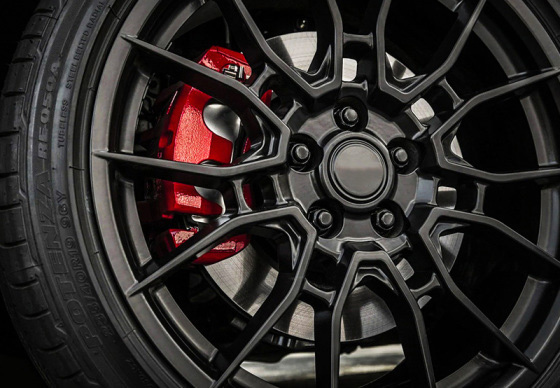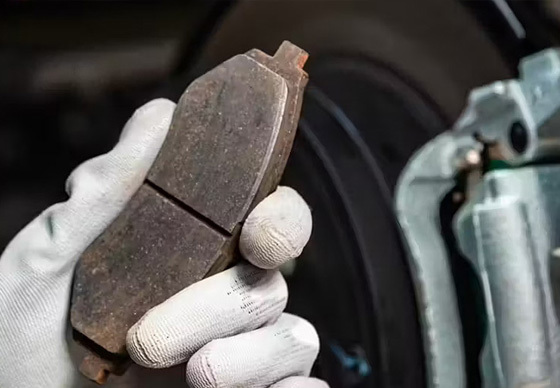Car small knowledge: how much do you know about brake pads
Oct 08,2024
No matter how good the performance of the car is, it is futile without excellent brakes.

One of the most important parts of a car! How much do you know about brake pads?
The brake system is one of the important parts of a car. No matter how good the performance of the car is, it is futile without excellent brakes. In the brake system, the brake pads can be said to be one of the most critical components. The quality of the brake pads determines the braking effect. Good or bad, it is very important for driving safety performance.
1. How to detect the condition of the brake pads? How to know that the brake pads need to be replaced?
There are several things to pay attention to. First of all, when the brake pads have reached the limit of replacement, you may obviously feel that your braking performance is not as good as before. In addition, at this time, you are also likely to hear a harsh sound from the brake when you step on the brake, which is actually a sign to tell you that you should change the brake pads.
This kind of harsh sound is usually made, mainly due to the friction between the special wear mark on the brake pad and the brake disc. If the brake pads wear down further, you may hear a harsher metal scratching sound, which is caused by the friction between the steel back material at the bottom of the brake pads and the brake disc. Finally, if you feel a significant vibration when you step on the brakes, this is actually one of the signs of brake pad wear.
If you experience these symptoms, please be sure to check the condition of your brake pads. Usually you should be able to see clearly without removing the tires; you only need to look inside your brake calipers and try Check the thickness of the brake pads.
2. There are many types of brake pads made of different materials on the market today, and the price gap between these products is quite large. Why is the reason and what impact will it have on the car?
Different brake pad materials can bring a completely different braking experience, the most important thing is to choose the right material to match your driving needs. At present, there are three main friction materials used in the manufacture of brake pads on the market, which are non-asbestos organic (Non-Asbestos Organic), semi-metal (Semi Metallic) and low metal (Low Metallic) materials.
First of all, let us explain the non-asbestos organic brake pads. In fact, non-asbestos organic brake pads are also called ceramic brake pads. Bendix's General CT and 4WD/SUV series brake pads use this type of material. Ceramic brake pads have the advantages of low noise, low powder, etc., and cause less damage to the brake discs, while at the same time providing stable braking performance.
As for rough vehicles such as pickups, trucks that are often towed or loaded, and ordinary cars, high-performance brake pads that can resist thermal degradation are required to ensure that sufficient gas can be released during the manufacturing process to improve the structural integrity of the brake pads.
Finally, there are brake pads made of low-metal materials. These brake pads contain high-content mineral abrasive materials, which can provide better braking performance and are suitable for performance and high-speed driving style.
Why do some cars produce so much brake dust?
Brake dust is a "by-product" produced during the braking process, and it is almost inevitable when it is common. It is composed of iron particles, mainly caused by direct friction between the brake pads and the iron brake disc. In addition to the metal material, the brake dust also contains some carbon slag, forming the so-called "brake powder". This black brake powder is not very elegant, but the good news is that it will not affect the braking performance.
P/S: You may notice that many European cars produce more brake dust and stick to the wheels. Why is this? The reason is that they use low-metal (Low Metallic) or semi-metal brake pads, Because the brake pads of this material can generate enough braking force to stop the car safely.
4. How often should we replace the brake pads?
The wear rate of brake pads depends on various factors, from the material of the brake pads, driving habits, brake disc conditions, and even whether the brake calipers operate as usual can affect the life of the brake pads. Usually brake pads can be used for 40000 to 60000 kilometers, but we have also heard of brake pads used for more than 80000 kilometers.
If you want more durable brake pads, please choose semi-metal brake pads. Compared with non-asbestos organic or low-metal brake pads, semi-metal brake pads usually have a longer service life.
NEXT:
Contact Us
Phone/WhatstApp:
+86-17531828113
+86-15165025890
E-mail:
Address:
Hebei Province Hengshui Gucheng County High-tech Development Zone Pioneer Park
PRODUCT SEARCH
Search And Quickly Find The Products You Need
The company's products can meet the personalized needs of different customers, and we sincerely provide customers with high-quality products and customized services. Our products are exported to Europe, America, the Middle East, Southeast Asia, Africa and other countries, and are sold well in various markets.
Continue Search OR Contact Us









